Will Vernon - Dig Diary - Five Weeks in Pompeii
Introduction
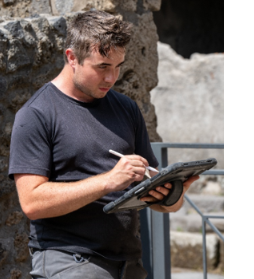 Archaeologists occupy a rather niche job role, so much so that many of us are not fully aware of what the job entails.
Archaeologists occupy a rather niche job role, so much so that many of us are not fully aware of what the job entails.
Before my university degree, the silver screen offered the only insight into archaeology. But, my recent five weeks in Pompeii have showcased that such portrayals could not be further from the reality.
If archaeology interests you, if it something you may want to explore, or perhaps you are looking for something new to read, then this blog is worth a read.
In my blog I talk about my recent participation on an archaeological project at Pompeii as an excavator. I highlight how I got onto the project, provide my thoughts on the experience, and discuss how I believe the experience has helped to advance my career prospects of becoming an archaeologist.
(Left) Me collecting data at Pompeii (Image Credit: Tony Campbell, Tracy Ford- Indiana State University).
The Application
The Classics department at the University of Warwick were aware of my interest in participating in archaeological fieldwork, so they would occasionally forward emails regarding opportunities offering fieldwork experience. One of such was Pompeii 1.14.
The project appeared both ambitious and exciting, and with URSS funding from the University of Warwick and the Warwick Classics Department, it became feasible. Applying became a no brainer!
The application process consisted of two stages. The first was a written application. For this I had to outline why I believed I was a suitable candidate to participate on the project. I passed this stage and was shortlisted to the second stage.
Stage 2 was a (very intense) video interview with the four project supervisors who enquired about my future career plans and how the project could benefit them.
A few weeks passed and I eventually got the news that I was on the Project! Having completed the fieldwork at Knossos in the summer of 2022, I think my ability to draw on this experience during both stages of the application greatly contributed towards my acceptance.
After Teams meetings, form filling, and packing, I was good to go. We can now fast forward to 10th June 2023, the date of my arrival to Naples.
The First Weekend
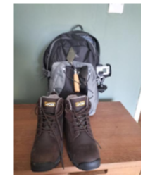 Pompeii 1.14 started with an early morning flight from Manchester to Naples. It had already been an extremely hot couple of weeks back home, but after a few minutes in Italy, I was dripping in sweat. Why I brought a fleece, I do not know!
Pompeii 1.14 started with an early morning flight from Manchester to Naples. It had already been an extremely hot couple of weeks back home, but after a few minutes in Italy, I was dripping in sweat. Why I brought a fleece, I do not know!
The journey from the airport to the modern town of Pompei, the location of our accommodation, was relatively straightforward- a bus and a train, and packing light - you can see my kit here (right) - made the journey much easier.
I reached the hostel around mid-day. Introductions were very casual over a few beverages in the garden, and it wasn’t until the late afternoon that all the team arrived, so we had plenty of time to break the ice.
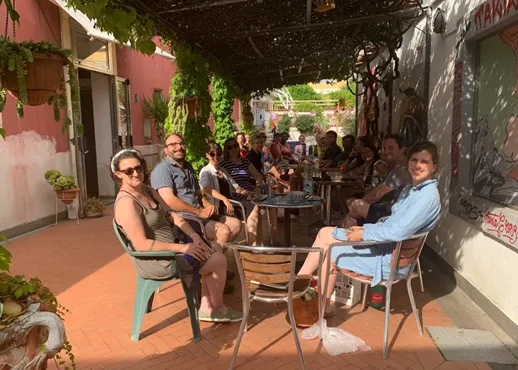
(Above) meeting the team - introductions with beer in the garden (image: Anna Marie)

My accomodation (above)
In the evening we had a team meal (below). My table ranged from students to established archaeologists with varying specialisations, so it gave the opportunity to talk about our interests in greater detail. The world of archaeology had been opened to me.

Sunday was another busy day. We were given a tour of Pompeii by the project manager, Allison, that was finalised with a visitation to the area that we would be working. Here, we were assigned our teams and supervisors, and given a detailed induction about the Insula (city block) within which we would be working (below).

Further information on this can be found here: https://www.tupompeii.org/research

Reconstructive interpretation of Insula I.14.1/11–14 - Image Credit: https://www.tupompeii.org/research
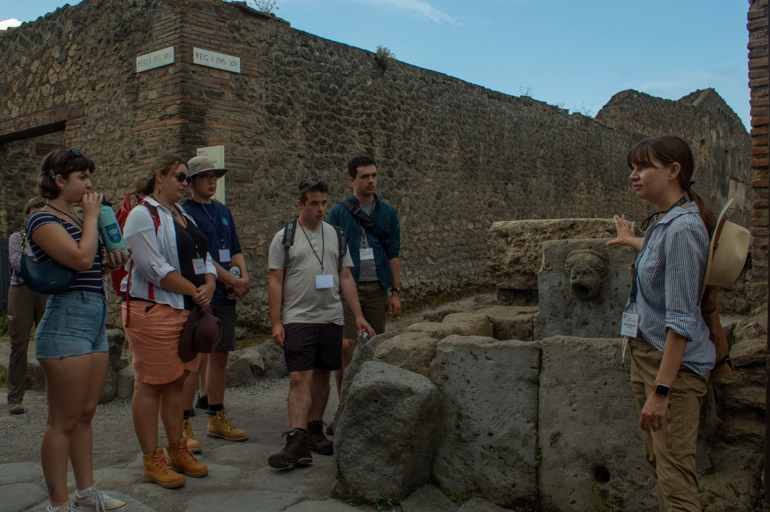
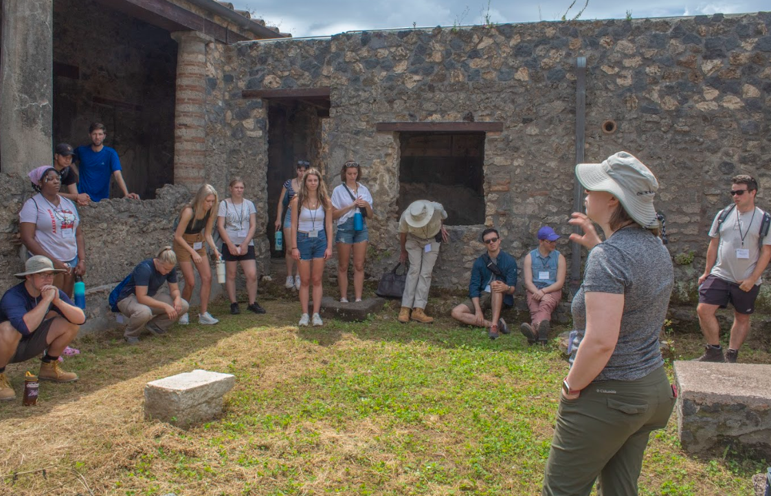
Tour of the Pompeii excavation site (images: Anna Marie)
The tour highlighted the necessity of visiting archaeological sites in person for the practice of informed research. Whilst textbooks and PowerPoint presentations certainly have their place, they fail to capture the surrounding environment of archaeological finds and tend to focus on a limited number of popular artefacts. Pompeii offers much more than I had anticipated!
With both nerves and excitement, I went to bed after an eventful two days.
Week 1
Monday officially marked the start of Pompeii 1.14 2023. Entering the site by displaying an official badge was a surreal moment, though I must admit, I perhaps enjoyed it a little too much!
But I was soon brought back down to earth. There was no messing around. We were put to work from the off. Weeding, shovelling, and wheelbarrowing were not tasks I had associated with excavations. These tasks were performed to make our excavation area tidy and easy to define.
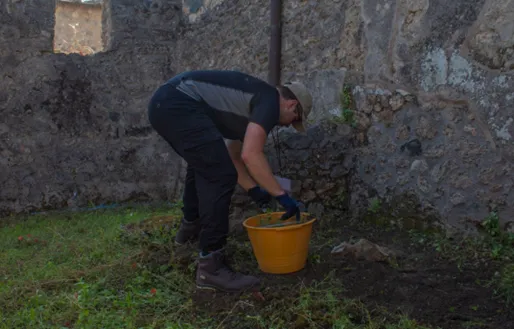
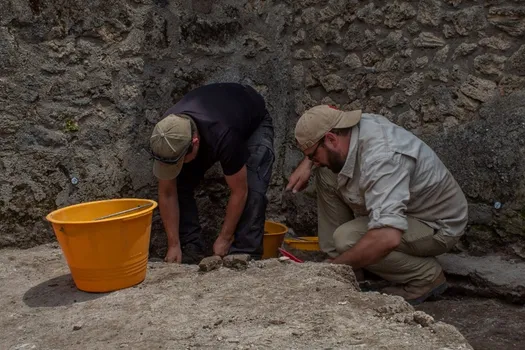
Working at the site (images: Anna Marie)
With this completed, we could now begin to excavate. Jordan, our team supervisor, taught us the tricks of the trade, including trowelling, noticing soil changes, and maintaining a clean and safe excavating area.
Mistakes were initially plentiful. I had the bad habit of digging holes rather than systematically removing layers, but Jordan was never too far away at this early stage to correct this, and over the week, I gradually improved.
We had a strong dose of beginner’s luck in Week 1 with some extremely exciting finds emerging. We first encountered a modern fill; all we were finding was Lapilli and cigarette buds. This was until we encountered a layer of Coccio Pesto (image below).

A piece of Coccio Pesto. Image Credit: https://en.wikipedia.org/wiki/Opus_signinum#/media/File:Haselburg_opus_signinum.jpg
Upon this was an unusual layer of ancient organic material. The contents of the material are pending full examination, but it has the potential to be an extremely informative about life in Pompeii. When the publication becomes available, I will be sure to share this on my Twitter page (see below), so be sure to check it out!
Week 1 showcased that archaeology is more than simply excavating, perhaps I had been watching India Jones and playing Lara Croft too much! Archaeologists are not lone wolves finding themselves in constant peril, they should rather be team players taking a systematic and safe approach to their work.


Sorting through the excavation diggings (images: Anna Marie)
In fact, I did not fully appreciate the depth and reach - the possibilities contained - within the field of archaeology until the final week, when I realised that I had barely scratched the surface. Each week we were introduced to the various practices involved with archaeology. In week 1, my team had a lecture from Environmental Archaeologist, Mark Robinson.
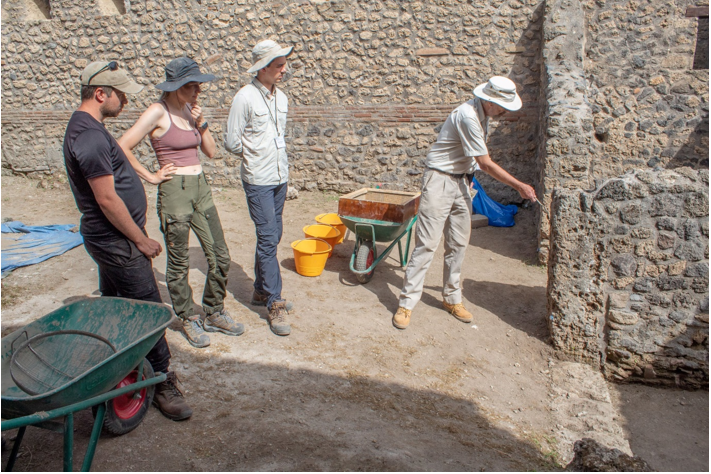
Mark Robinson and the team (image: Anna Marie)
The insights that Mark could gather from a quick examination of stone and soil was incredible, and it highlighted the importance of having diverse skillsets on archaeological projects. Without his input, the excavation would have been much slower.
His introduction has certainly inspired me to explore environmental archaeology further in my own time.
`Week 1 also presented some unforeseen challenges that I had to adapt to over the remainder of the project. Here are the three biggest challenges.
Weather: The first week was luckily the coolest week, but even with the cloud protection, I don’t this I applied enough sunscreen. My first few showers were quite painful!
Clothing: Some of the clothing I brought were far too heavy for the excavation. This added to the discomfort.
Physicality: Archaeology includes working is some very strange positions, so muscle pain was quite a memorable feature!
Week 2
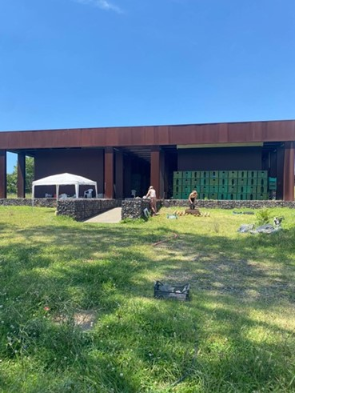
Week 2 was another eye-opening experience into the world of archaeology.
The delicate condition of the organic material found the previous week required more experienced excavators since we were still beginners, so this was performed by our supervisors. Consequently, half of our area was off limits for most of the week, and we performed other tasks.
Week 2 was my first encounter with ‘the monster’, it was a building that I would become very familiar with. Let me introduce you to it.
The Monster is the area where excavated material is processed at Pompeii, ready to be sent to storage.
Pottery washing was the first task I performed at the Monster. We cleaned most of the pottery with a pressure washer, but the more delicate ceramics were cleaned with toothbrushes. Pottery washing was less impactful on the body, so being moved to do it could sometimes be a relief.
When ceramic material is excavated, it is sent to be washed to be more visible. This can allow ceramic specialists to gain more information about the pottery- you would be surprised how much of the decoration was unnoticeable until it was washed. Below is a photo of me washing some pottery! (image: Anna Marie).
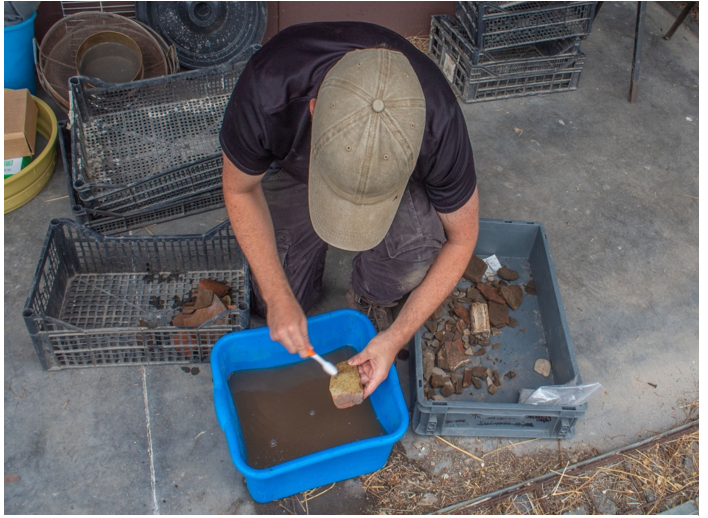
The excavating we did perform produced some exciting finds, perhaps my personal favourite from the whole season, this being an extremely well-preserved oil lamp. See it for yourselves!

I had the temptation to yank it out of the ground all week, but this would be very bad archaeological practice. Instead, we systematically removed the topsoil until we could extract it without damaging the lamp and its surrounding context.
Week 3
Week 3 marked the midpoint of the project. We were now in full swing, and time was passing so fast!
We were finding our individual strengths and preferences but also bonding well as a team. Jordan’s watchful eye was hovering over us less frequently and he had greater trust in us to work independently to the point that we were responsible for recording data.
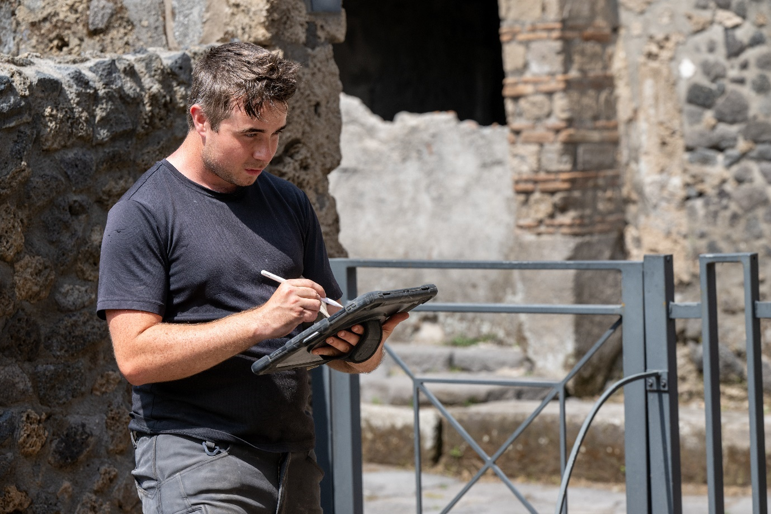
Above: Recording data at the site (Image Credit: Tony Campbell, Tracy Ford- Indiana State University)
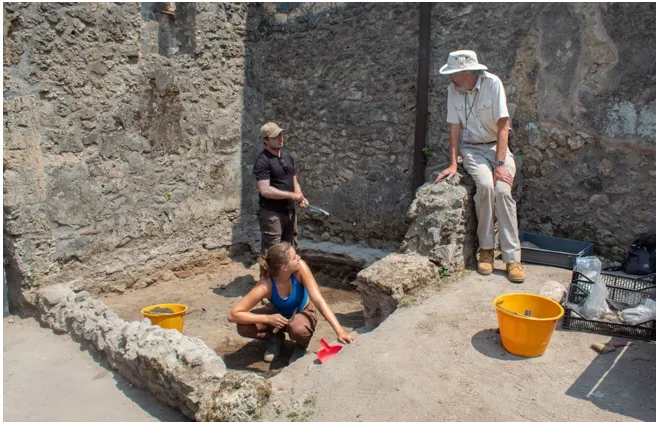
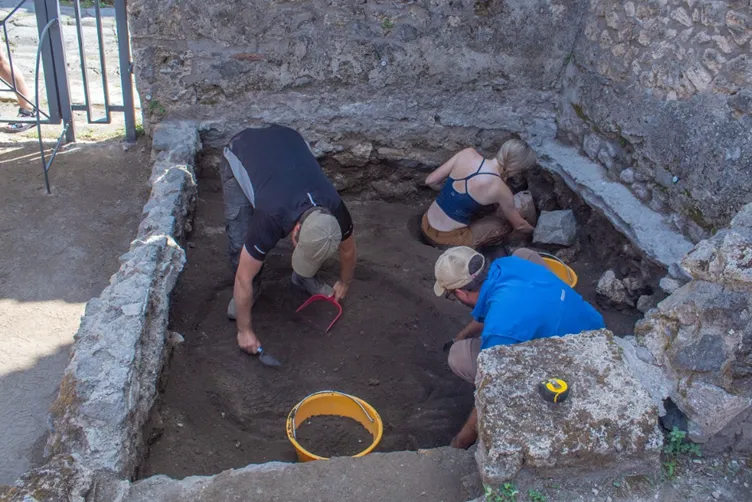
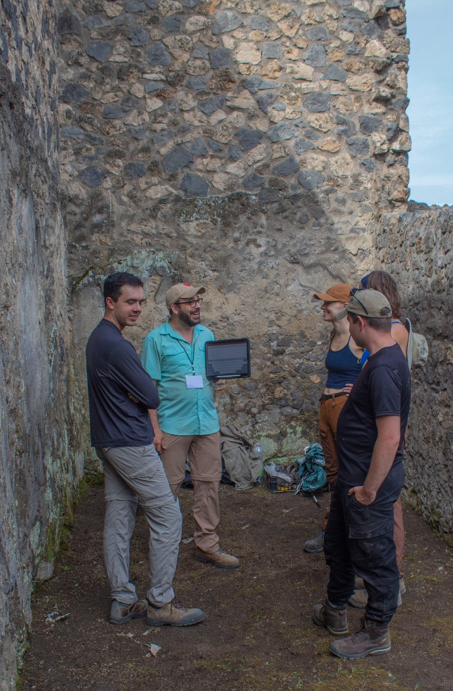
(Above) Hard at work, and learning on the job (images: Anna Marie)
The organic material from the previous week had been safely removed and stored to be tested, so we had full reign of our zone again.
Week 3 produced more insightful finds. My personal favourite was a very well-preserved vessel from a soakaway (below). The contents of the vessel still contained traces of human excrement, so this was examined under the microscope to give an insight into the dietary habits at ancient Pompeii.

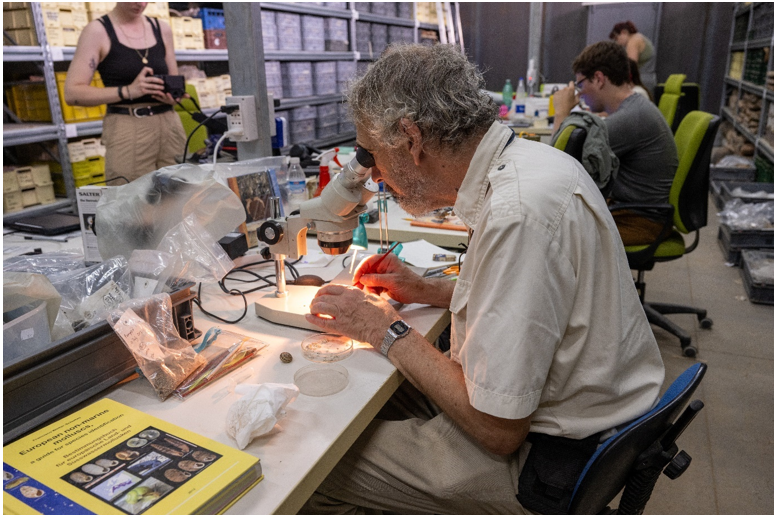
Examining organ material at Pompeii - (Image Credit: Tony Campbell, Tracy Ford- Indiana State University)
I also had a fruitful third week at the Monster. I learned another aspect of archaeology known as ‘finds processing’.
Finds processing involves recording information about the excavated finds onto a database. This includes features like their dimensions, weight, and material. The gathering of this information can offer more information on the context they are found within. By dating of a coin, for instance, we can find the Terminus Post Quem (the earliest possible date) of an archaeological layer that the coin was discovered within.

There was also plenty of variation with the artefacts making their way in including coins, glass, metallic objects which meant there was never a dull moment.
Coins were my favourite artefact to process because they involved a lot of detective work. We would try to identify the emperor on the coin and the legend to compare it other similar coins from an online database, allowing us to accurately date them. The coins were quite frequently rusted, so saying what we see sometimes caused debate.
Week 4
We were now over the hump of the project and the spoil heaps were getting high. Week 4 proved to be yet another busy week.

Lying on the spoil heap (image: Anna Marie)
We reached the archaic soil in our trenches which marked the end of our excavation in this area. So, we moved onto another area. With only two weeks left, there was no time for slacking. Since this had to be fully excavated and the finds processed at the Monster.
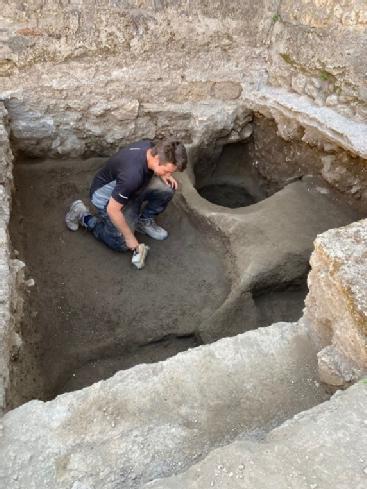
But very soon into the excavation of our area, it became evident the area was special. We gradually uncovered steps that were initially thought to be a drainage system. What was only the week before the place where we had coffee was now an out of bounds archaeological area!
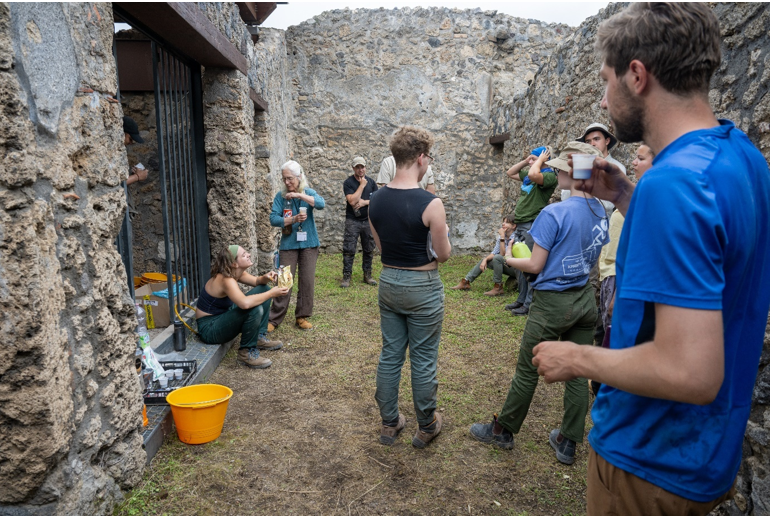
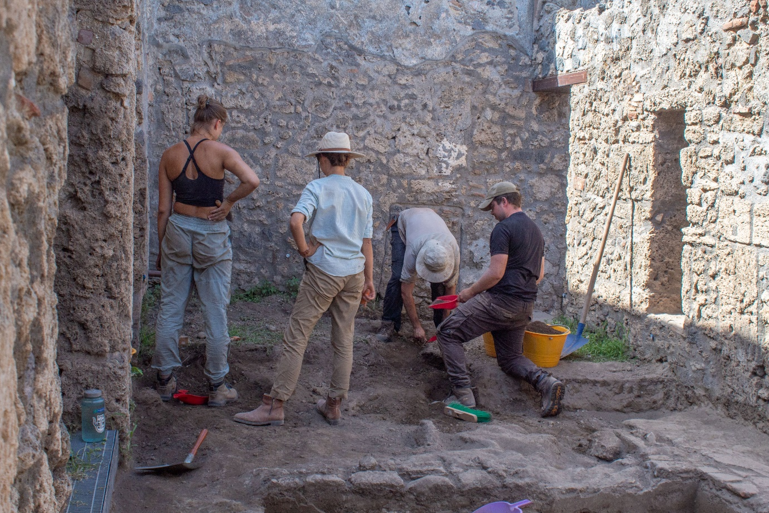
A before and after shot of the excavated basin (Top image: Tony Campbell, Tracy Ford- Indiana State University; bottom image: Anna Marie)
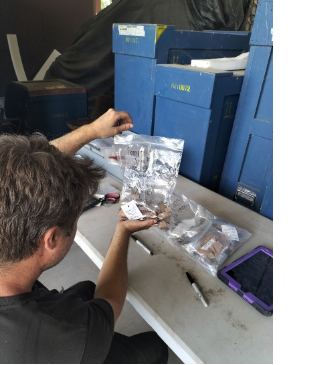
At the Monster, I worked on ‘pottery sorting’.
Due to the large quantities of ceramic material that had been excavated over the previous weeks, there was a lot of pottery that needed processing, ready to be stored. So, there was plenty of opportunity to get some practice in.
Pottery sorting followed on from pottery washing. It wasn’t too dissimilar from the finds processing that I did the previous week. It involved categorising ceramics into components like function, style, and part, ready to be then weighed and photographed. This information can then allow insights into what was happening at a specific time and place.
I had performed very similar work as part of the KLASP project at Knossos with Warwick, so it was a matter of getting into the swing of it again.
Left is an image of me bagging and labelling ceramics ready to be put into storage.
Week 5
The fifth and final week was upon us. Fatigue was kicking in, but we had to keep our focus.
As well as ensuring our areas were fully excavated and processed at the Monster, our trenches still had to be backfilled. One final push was needed.
Despite the tiredness, our team powered through, and by the midweek we had fully excavated our area, it was a basin (below)!
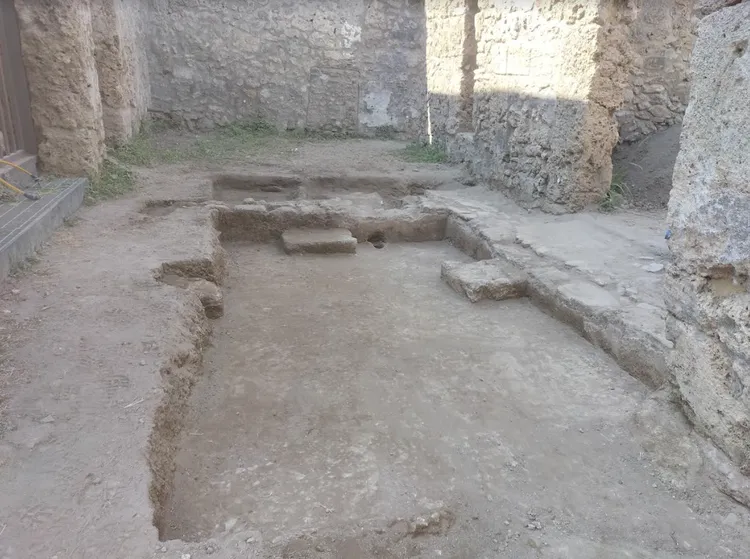
From our work at the Insula, we now had a washroom, a garden, a restaurant, and another commercial zone (which may be determined by the results of our samples of the organic material). The uncovering of the basin will prove to be extremely important for determining the interactions of the space functioning within our insula.
The final two days were dedicated to backfilling our excavated areas (below). Although it was a simple task of refilling our excavated areas with the extracted soil, it involved many labour-intensive tasks: shovelling, wheelbarrowing, and dumping. To add to this, the weather had become increasingly hot over the last few days.
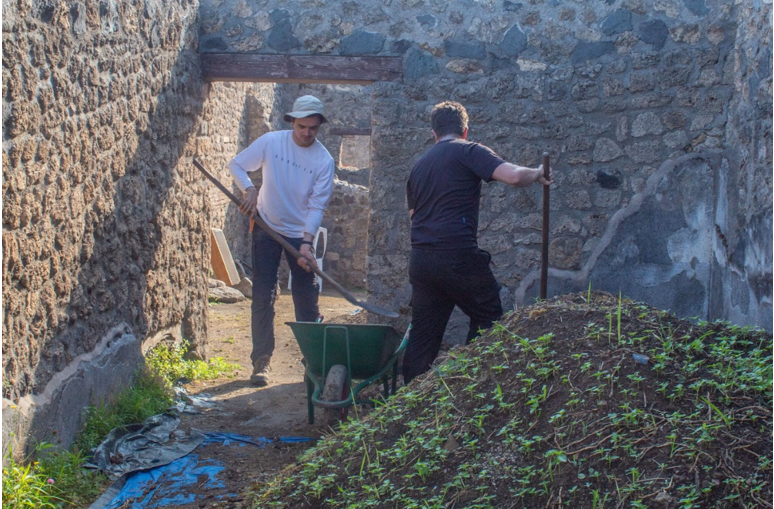
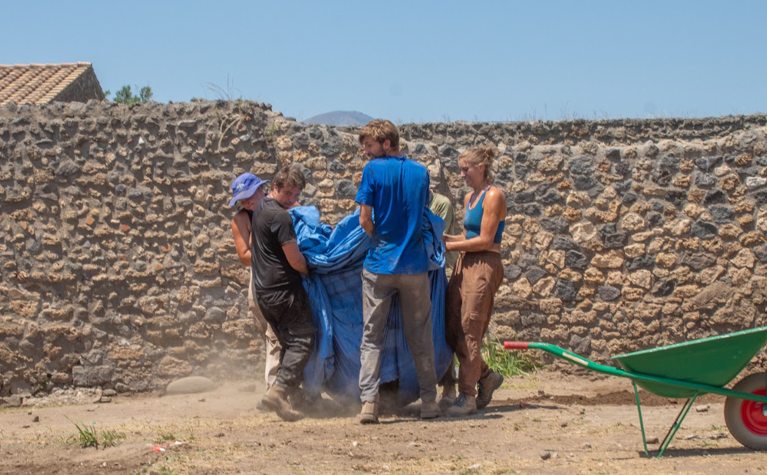
Backfilling the excavation site (images: Anna Marie)
To everyone’s relief we powered through the backfill with flying colours. We finished just after lunch on the final day which gave us some time to celebrate our efforts over the last five weeks.
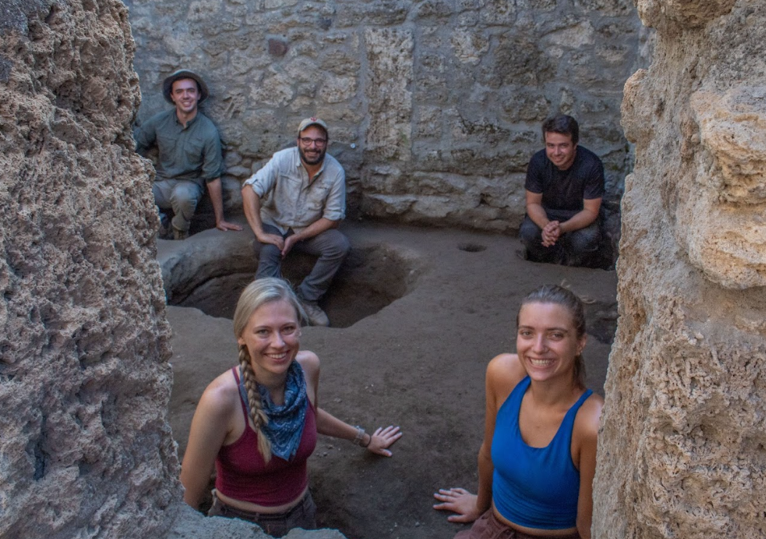
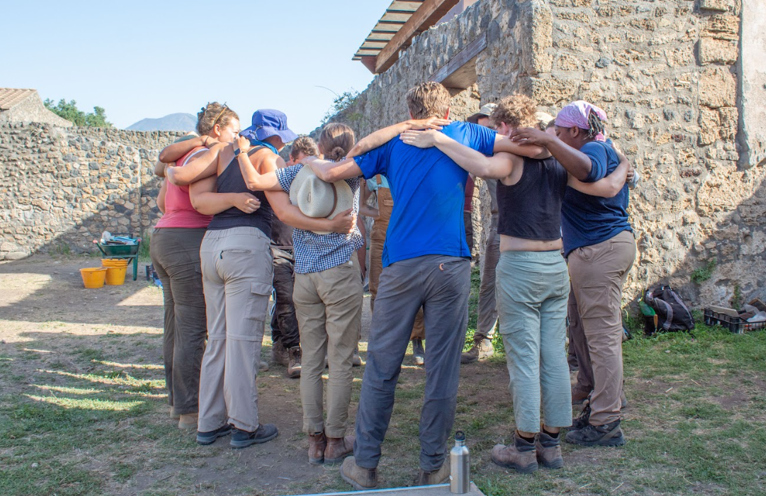
The final day digging (image: Anna Marie)
Finishing the excavation was bittersweet. Goodbyes were hard, my workmates had become friends. But it was also good to reflect on all that we had achieved over the last five weeks and what this will contribute to research.
We ended the evening with a final meal and farewell speeches from the supervisors. That night, I made my way home with fond memories.
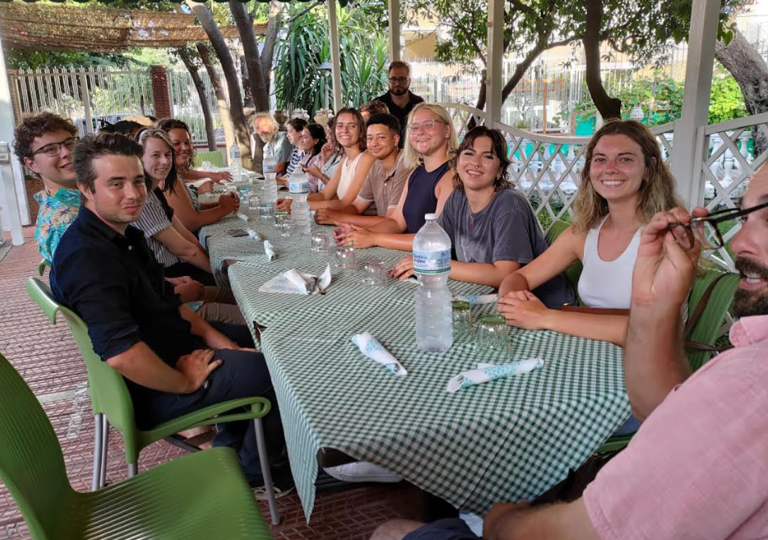
A last meal with the team (image: Anna Marie)
Free time
Whilst the project was the reason we were at Pompeii, we had plenty of time in the evenings and at the weekends to do our own thing. This was spent how we wanted so we all had individual experiences.
We were often too tired to do anything strenuous after work, so this time was often spent unwinding with drinks at the hostel, playing card games, and conversation over food.

Unwinding (Image: Tony Campbell, Tracy Ford- Indiana State University)
By the weekend we were well energised and went further afield. Personally, I found it important to have some time alone, so I did solo some exploring of the local towns and villages, in Naples to immerse myself within the Neapolitan culture. Check out this chance encounter! https://twitter.com/i/status/1687092015169691648
I also spent some of the weekends with the team. We would often go to the beach to further rejuvenate, checking out new restaurants and going to bars in the evening. On occasion, archaeology did not always end with the excavation. We visited more of the world renowned archaeological sites in Naples such as Herculaneum and the underwater site at Baiae, but this time as a tourist.
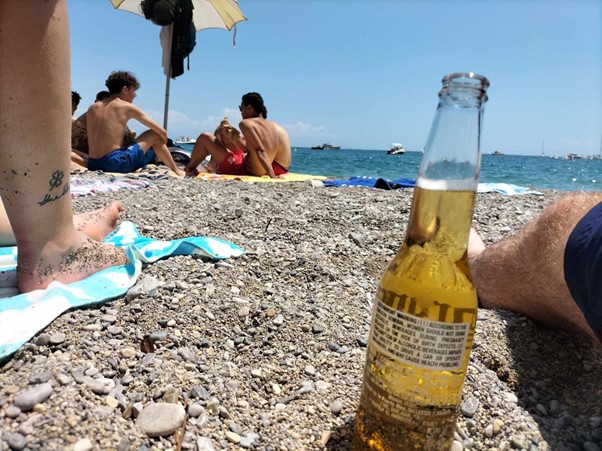
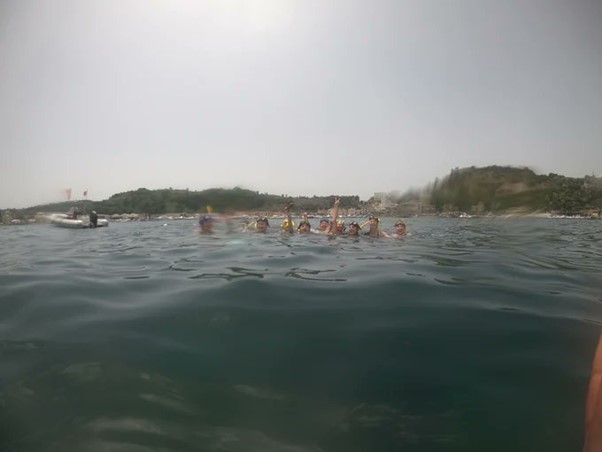
(Top) At the beach (image: Anna Marie); (bottom) a visit to the archaeological remains at Baiae, now underwater (image: Anna Marie)
Expenses and Funding
An aspect of the project that needs addressing is the cost involved with participating on archaeological projects. In comparison with similar projects, Pompeii 1.14 was less costly - £1500 which included participation, accommodation, and dinner. But other costs were also involved such as medical certificates, equipment, flights, evening meals, and general living. These extra costs amounted to around just under £1000.
There is no simple solution for making archaeological projects more affordable for students because this means such projects have to find alternative sources of funding. But I believe more can and should be done to make them more affordable. You can read an article here about how the problems of affordability.
I was fortunate enough to receive substantial funding from the Warwick Classics Department and a URSS bursary which collectively covered the project, flights, and equipment. Without the funding the project wouldn’t be feasible.
I am sure many of you reading this would be in the same position, so I would strongly advice looking at funding options. Your university, your university department and archaeology related grants are the sources that I would recommend from organisations such as The Classical Association https://classicalassociation.org/grants/ . It might just make the impossible possible.
Career progression?
My post-university career plan is to work in the archaeology and heritage sector. Starting a career as an archaeologist, particularly in the earlier stages, can possess challenges. Some companies require work experience to even be considered for the role of a trainee (which to my mind is perplexing)! So having five weeks’ worth of excavating experience is highly advantageous, especially with consideration of the prestige of Pompeii.
But as this blog has often emphasised, there is more to archaeology than excavating. Archaeological projects also involve effective communication, listening and teamwork. So, you should be able to develop and perform these skills on them. Moreover, project leaders can act as referees and vouch for your character and work ethic.
My opinions here have derived from advice received, my individual research, and my five weeks in Pompeii. It could be that the realities of a career in archaeology are very different- I will no doubt find out soon enough!
I will be updating my (potential) career opportunities on my Twitter page, so if you want to discover if Pompeii 1.14 did indeed enhance my career prospects, then feel free to give me a follow @archaeowanderer
In addition, this account has access to further information about the experience, so if you have any questions about the experience, or anything else, then do not hesitate to drop me a message.
